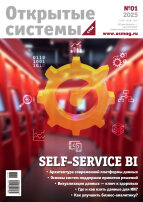_300x.jpg)
COVER FEATURE
BUSINESS ANALYTICS STATE OF THE ART
Business Intelligence, 20 Years Later
In the late 1990s, when software engineering and development tools began to burgeon, while transactional processing achieved a level of maturity and large organizations accumulated sizable data amounts, the building of data warehouses and datamarts began. The search for solutions to offer insights and analytics to business users while deeply involving them in data analysis was a top priority then. The outcomes of that activity were summarized in a work published in 2003. Now twenty years have passed: what shifts in the BI area have happened over the period, what does the industry use now, and what should we expect in the near future?
Valery Artemiev (viart1951@gmail.com), independent consultant (Moscow).
Highlight: The Way Data Conquered Business
Having fully recognized the value of data, Russian companies are transitioning from a system-centric to data-centric IT architecture. The keys to success of such a transition include high-quality and synchronized data, well-structured storage, and the right analysis tools enabling to store data outside of BI systems.
Maria Averina (maverina@navicons.com), management partner, Business Analytics Department, Navicon (Moscow).
Flexible Data Use in a Data-Centric Architecture
In a data-centric architecture, data is accessed through a logical data warehouse. A seamless transition from a classic architecture to a data-centric one that enables data representation flexibility and integrity could be enabled via ontology models.
Anna Begler (begler@trinidata.ru), analyst, Konstantin Kondratiev (kondratiev@trinidata.ru), director, TriniData (Yekaterinburg).
Developing a Data Culture
With data being a valuable business asset, training programs aimed to improve data analytics and availability competencies play a crucial role in data monetization.
Pavel Shorokhov (shorokhov@magnit.ru), Chief Data Officer, Magnit (Moscow).
PLATFORMS
Supplier Portal: Facilitating Contractor Interoperation
For major product engineers dealing with many contractors that use various automation systems, it is crucial both to ensure unified planning and build reliable collaboration workflows. Special-purpose applications, such as the Supplier Portal, could offer a solution to the challenge.
Nikita Zaytsev (ZaytsevNV@kamaz.ru), Kamotive Project head business analyst, KAMAZ Innovation Center (Moscow).
MOMENT OF TRUTH
Cutting-Edge Databases: We Still Have a Choice
The exodus of Western database vendors from the Russian market together with ongoing import substitution efforts have escalated the search for alternatives enabling local businesses to continue their operations. The Kroogi Gromova Project has researched the current Russian database market, attempting to systematize the results, and created a visual representation that could help users choose the system most appropriate for their needs.
Stanislav Alekseyev (stanislav.a@businessqlik.com), business analyst, BI Consult (St. Petersburg).
OPINION
What Kind of AI Do We Need?
The progress of deep learning techniques has led to a host of achievements in the field of text and image processing, causing an AI revolution. However, most of the innovation happening in the area is used to address entertainment industry needs. Is that necessary that much, though? What kind of AI does society actually need?
Vladimir Soloviev (vs@ciars.ai), CIO at CIARS and chair of Applied AI Department at Moscow Technical University of Communication and Informatics (MTUCI); Sergey Makrushin (sm@ciars.ai), Research Director at CIARS and assistant professor of Applied AI Department at MTUCI (Moscow).
Lounge OS
Sberbank’s Data Factory
To be able to make timely data-driven decisions, as many employees as possible should be engaged in using data, but how could that be achieved? Sberbank’s Data Factory enables quick testing of various business hypotheses to help find efficient solutions and put machine learning models into operation.
Irina Sheyan (rrisha@osp.ru), staff writer, Open Systems.DBMS Journal (Moscow).
OS ACADEMY
Designing and Modeling Telecom Systems
Both standard approaches and custom models could be used when designing a telecommunications system. Today, however, semantic technologies are needed to address most applied problems, which makes creating a semantic description of telecom systems based on existing ontology models a highly important task.
Natalia Zhukova (nazhukova@mail.ru), assistant professor, Alexander Vodiakho (aivodyaho@mail.ru), professor, Igor Kulikov (i.a.kulikov@gmail.com), undergraduate student, Saint Petersburg
OS MUSEUM
Victor Glushkov: Computer Science Pioneer and Digital Society Visionary
While working in any field of science, one should not engage in just a single, spur-of-the-moment problem without seeing its long-run potential – that’s what Victor Glushkov believed, a cybernetics pioneer, contributor to the automata and supercomputer theory, and the author of a digital government project. On August 24, 2023, he would turn 100.
Olga Kitova (Kitova.OV@rea.ru), chair of Informatics Department, director of Cognitive Sciences Competence Center, G. Plekhanov Russian University of Economics; Vladimir Kitov, senior fellow, AI, Neurotech and BI Lab, G. Plekhanov Russian University of Economics (Moscow).
Electrotechnical University LETI (St. Petersburg).
